Physical Address
304 North Cardinal St.
Dorchester Center, MA 02124
Physical Address
304 North Cardinal St.
Dorchester Center, MA 02124

Known for legendary waves like Pipeline, Hawaii's surf spots offer everything from beginner-friendly beaches to expert breaks that'll challenge your limits.
When 23-year-old Jake Marshall scored a perfect 10 at Pipeline’s legendary break, he’d spent months preparing for Hawaii’s powerful waves. You’ll need similar dedication to make the most of your Hawaiian surf trip, whether you’re a beginner or an expert. From the gentle rollers of Waikiki to the monster swells of the North Shore, each island offers distinct surf experiences at different price points and skill levels. Let’s explore how to plan your perfect Hawaiian surf adventure without breaking the bank.
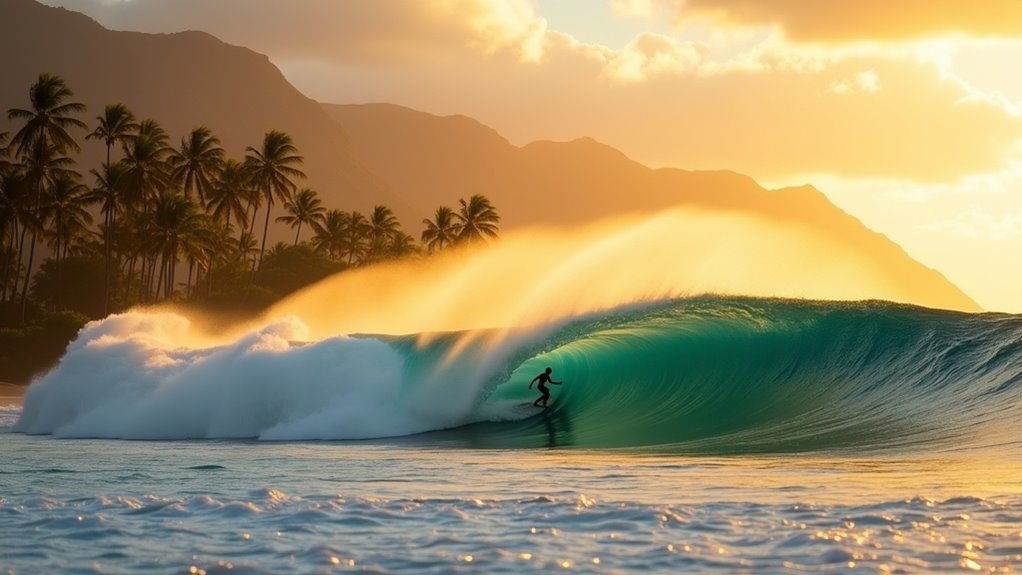
When planning your Hawaiian surf adventure, timing can make or break your experience. For beginners, book your trip during summer months (May through September) when gentler waves grace the south and east shores, particularly at Waikiki Beach and Lahaina.
Book your Hawaiian surf trip in summer months for the best beginner-friendly waves at iconic spots like Waikiki Beach.
If you’re an experienced surfer seeking powerful waves, aim for winter (November through March) on the north and west shores. Oahu surf school provides expert instruction for all skill levels in ideal learning conditions.
To avoid crowds and save money, target the shoulder seasons of early spring (April-May) or fall (September-October). These changing periods offer versatile conditions suitable for all skill levels, with fewer travelers competing for waves.
For maximum solitude, consider February, March, or October, when you’ll miss both the winter contest crowds and summer tourism rush.
Just remember to check local forecasts regularly to optimize your surfing days.
For the most extreme challenge, head to Maui’s Jaws, where tow-in surfing is necessary to tackle the 60-foot monsters.
If you’re seeking more manageable yet still advanced waves, Honolua Bay delivers long, perfect rights with excellent barrel sections. This popular Maui spot is home to many talented young surfers who showcase their skills daily.
All these spots demand expert-level skills and extensive big-wave experience.
Winter months (November-February) consistently deliver the most impressive conditions, but be prepared for strong currents and variable conditions.
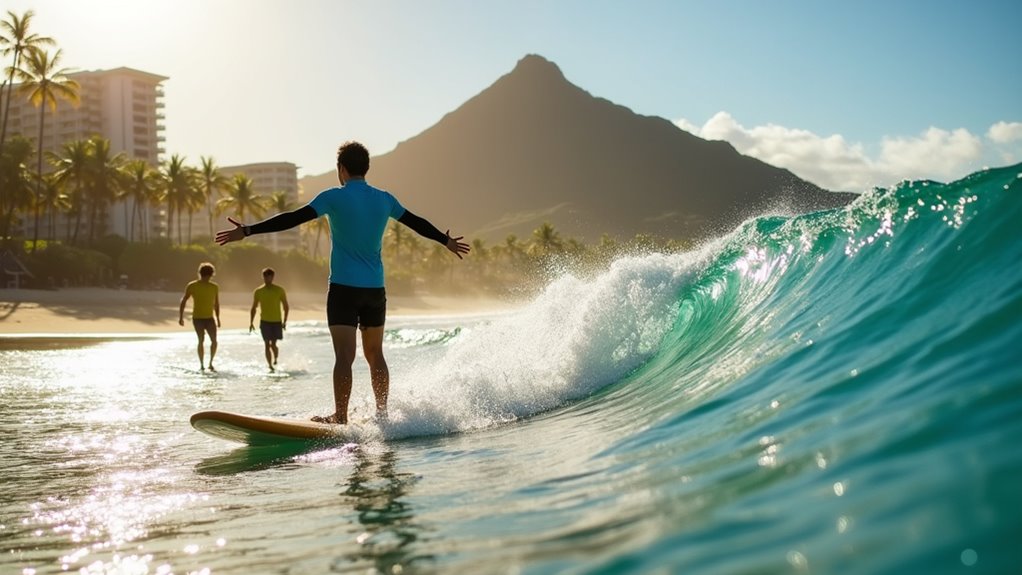
While expert surfers chase massive waves, Hawaii offers plenty of gentle spots perfect for those just starting their surfing journey.
You’ll find beginner-friendly beaches across all major islands, each with unique advantages.
On Oahu, head to Pua’ena Point or White Plains Beach for consistent, gentle waves. Summer months provide ideal conditions with smaller swells and calmer waters.
Maui’s Lahaina Breakwall and Kihei Cove provide sheltered spots with manageable surf.
If you’re visiting Kauai, try Hanalei Bay or Poipu Beach, where you can progress at your own pace.
The Big Island’s Kahalu’u Beach Park offers a protected reef break with lifeguards and amenities.
Before hitting any beach, check local surf forecasts and consider taking lessons from certified instructors.
Most beginner spots offer rental equipment and surf schools, making it easy to start your surfing adventure without major investment.
Before paddling out into Hawaiian waters, you’ll need the right gear to guarantee a safe and enjoyable surfing experience. For beginners, start with a longboard rental to test your skills before investing in equipment. A quality surf poncho is essential for changing comfortably on the beach without struggling with towels.
Beginners should rent a longboard first – it’s the smart way to test the waters before committing to surf gear purchases.
Don’t forget reef-safe sunscreen and a quality rash guard to protect your skin from sun and board rash.
Consider taking surf lessons to learn proper technique and local etiquette while making the most of your gear.
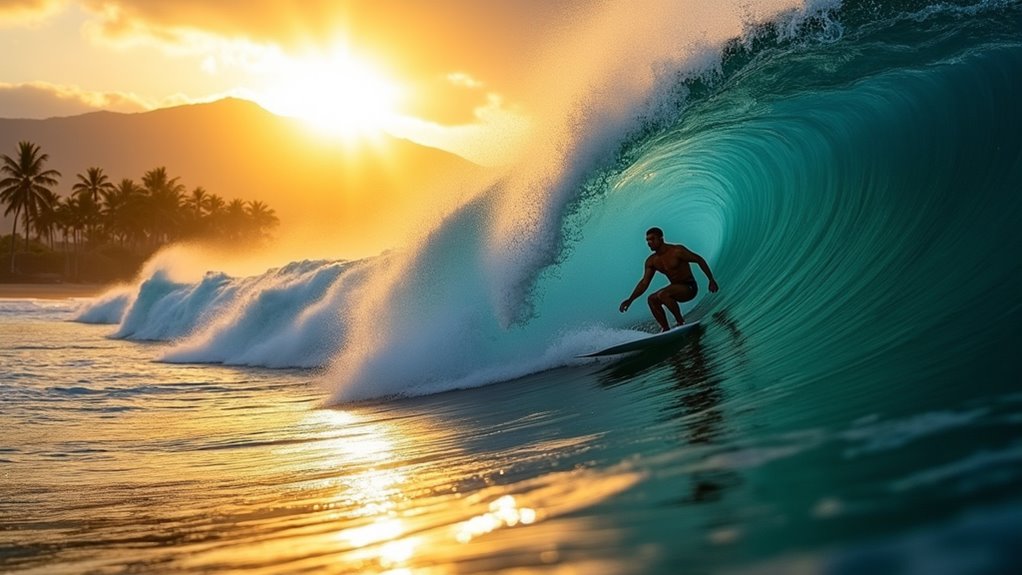
The North Shore of Oahu serves as Hawaii’s ultimate surfing destination, offering waves for every skill level throughout the year.
If you’re a beginner, head to Pua’ena Point or Chun’s Reef, where gentle waves and wide channels make learning easier. During summer months, you’ll find smaller, more manageable swells perfect for building confidence. With over 20 surf spots spanning from Haleiwa to Velzyland, you’re sure to find the perfect wave for your ability.
For experienced surfers seeking adrenaline, winter brings massive waves to legendary spots like Banzai Pipeline and Waimea Bay.
Before paddling out, check the conditions and look for lifeguard presence. You should aim to time your visit according to your skill level – summer for beginners, winter for experts.
Local surf schools offer lessons year-round, and you can often catch professional competitions during peak season.
Just remember to respect local etiquette and stay aware of currents and marine life.
Beyond Maui’s famous breaks lies a treasure trove of lesser-known surf spots offering uncrowded waves and authentic experiences.
You’ll find S-Turns at Pohaku Park delivering long, clean waves suitable for all skill levels, while Olowalu Beach’s jetty spit serves up perfect summer lefts and versatile peaks for intermediate surfers.
Due to island blocking effects, summer conditions often produce weaker waves across many Maui spots.
Pack your board and explore these hidden gems, where reef breaks and local vibes create an authentic Hawaiian surf experience.
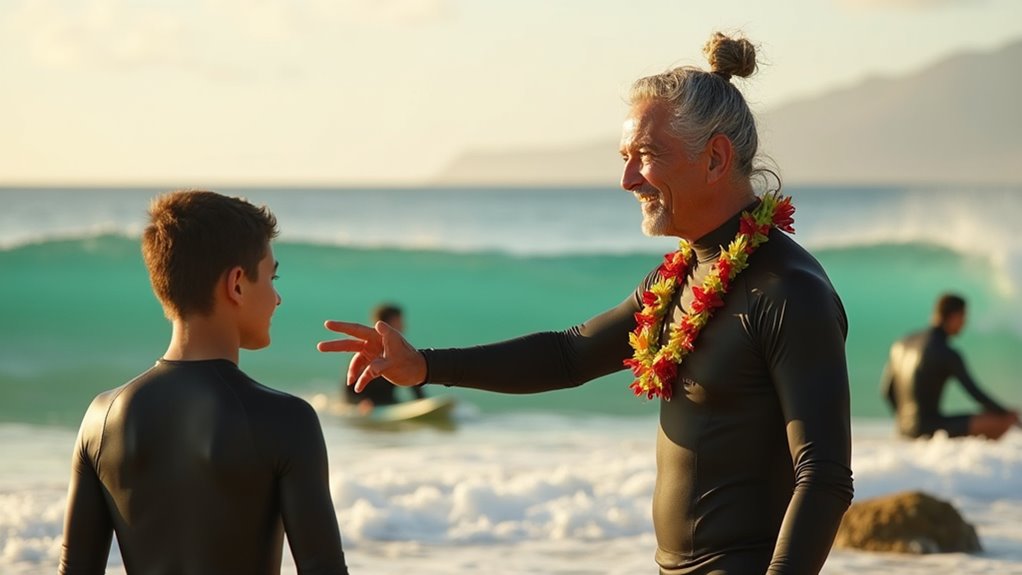
Mastering Hawaii’s surf spots requires more than just finding the perfect wave – you should aim to understand and respect the vibrant local customs and established wave etiquette.
Always give the right of way to surfers closest to the wave’s peak, and never drop in on someone’s wave. When paddling out, use designated channels to avoid interfering with active surfers. Keep your board under control and attached with a leash for everyone’s safety. For beginners, it’s essential to practice sitting and paddling fundamentals before venturing into deeper waters.
Show respect by greeting other surfers and engaging with the local community. You should aim to protect the environment by avoiding coral reefs and participating in beach cleanups.
Stay away from river mouths and protected marine areas, and don’t surf after heavy rainfall. If you’re at a crowded break, wait your turn and maintain clear communication with fellow surfers.
Understanding Hawaii’s weather patterns is essential for planning your surf adventure, as conditions vary dramatically between seasons and locations.
If you’re a beginner, target the summer months from May to September, when the South Shore offers gentler waves, particularly at Waikiki Beach and Lahaina. Early morning sessions provide optimal wind conditions for smoother wave faces and better surfing experiences.
Advanced surfers should plan for winter trips between November and March to catch powerful north swells at spots like Sunset Beach or Jaws.
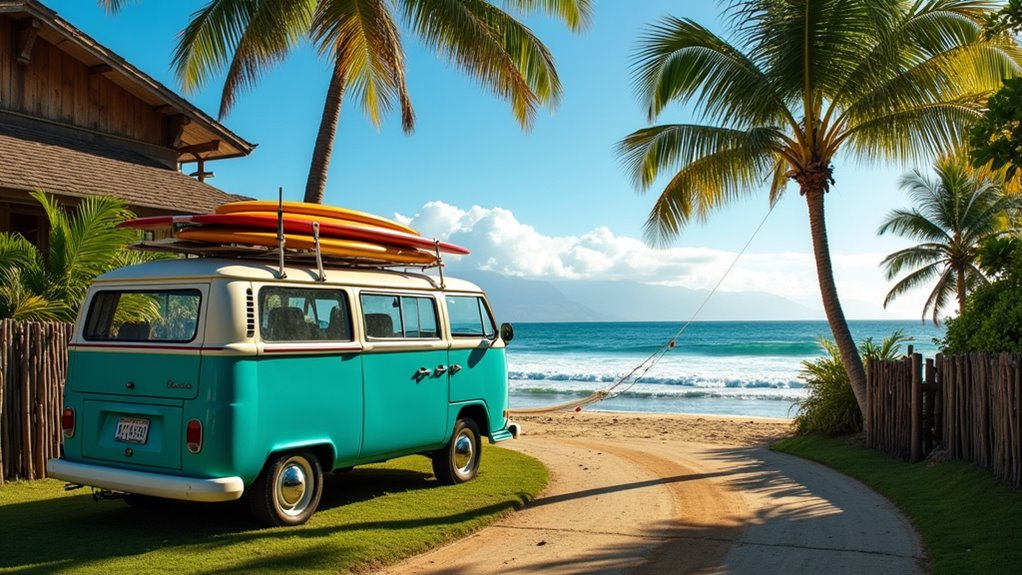
Once you’ve identified your ideal surf spot in Hawaii, securing convenient transportation and accommodation becomes essential for a successful trip.
You’ll find regular flights connecting major airports, and you can rent a car for around $50 daily to access remote surf spots. If you’re staying near popular breaks like Waikiki, public buses and ride-sharing services offer affordable alternatives.
For accommodations, you’ve got options for every budget. Beachfront resorts provide convenience and surf lessons but cost more, while budget hostels start around $100 per night. The legendary North Shore of Oahu offers world-class surfing accommodations near iconic spots like Pipeline and Sunset Beach.
Consider vacation rentals through Airbnb for group trips, or check out specialized surf camps that bundle lodging with lessons. If you’re heading to spots like Pipeline or Hanalei Bay, you’ll find plenty of nearby places to stay, from luxury hotels to basic camping grounds.
While surfing might be your primary focus in Hawaii, combining wave sessions with diverse island activities creates an enriching and complete vacation experience.
You’ll find numerous ways to blend your surf sessions with both water and land-based adventures that won’t break the bank. Experienced instructors are available to help surfers of every ability develop proper techniques.
Consider multi-day packages that bundle various activities together, often providing better value than booking individual experiences.
Strike while the iron’s hot and book your Hawaiian surf adventure today. You’ll find waves for every skill level and budget across the islands. By planning your trip around seasonal swells, packing the right gear, and respecting local customs, you’re set for an unforgettable experience. Whether you’re catching your first wave at Waikiki or challenging Sunset Beach’s monsters, Hawaii’s surf scene delivers paradise without breaking the bank.